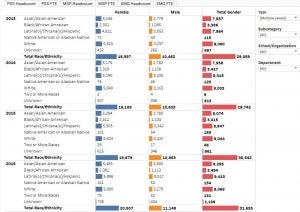Fellow Bruins,
You may have already seen it: a photo of smiling college students holding up posters saying, “Get your agenda out of my bathroom!” “There are only two genders!” “Transgenderism is a mental disorder!” Some of these are UCLA students, affiliated with the Bruin Republicans.
The fact that someone might say something inflammatory, offensive, or disturbing in social media is hardly news. And I have neither the capacity nor interest in commenting on all such posts, pics, tweets, vines, or memes. Frankly, the picture was taken at UC Santa Barbara, so the physical nexus to UCLA’s campus climate is remote. That said, the social meaning of viral posts, fueled by local TV newscasts, is always hard to predict. And sometimes timing makes all the difference.
On the same day that this photo was taken, Friday, May 6, the LGBT Campus Resource Center at UCLA celebrated its 20th anniversary. In the audience were folks essential to the Center’s formation, growth, and leadership, as well as university luminaries such as former Chancellor Charles Young and current Chancellor Gene Block. I had the honor of giving closing comments, in which I invoked three words: “center,” “blindspots,” and “gratitude.”

1. Center. To celebrate the Center, I riffed on what it meant to be at the “center,” not merely the periphery or margins. When most people think about “diversity,” race and sex come first to mind. LGBT often trails behind. Accordingly, the LGBT community reasonably wonders whether it is a polite afterthought on matters of equity, diversity, and inclusion. I expressly acknowledged that concern. More important, I expressly rejected that view. I made clear that the LGBT community belonged at the center, not at the fringes of equity work. Having made this affirmation just a few days ago, I couldn’t easily let this controversy pass without comment.
2. Blindspots. Next, I pointed out that we all have blindspots. I started with my own. Because I’m a racial minority, I tend to be sensitive about race. But I’m a man, so I can be a little dense about gender. I’m also straight, and at times a bit clueless about LGBT issues. I have to start by admitting that I have these blindspots, so that I can work to overcome them. To be clear, no one is immune. As I stated last Friday, even within the LGBT community, there are difficult blindspots that must be addressed, such as fairness based on race, gender, and class.
Unpacking gender. I want to use this theme of “blindspots” to engage students who would gladly hold up posters that exclaim, for example, “There are only two genders!” Notice that the poster did not say there are only two “sexes.” But what is the difference between sex andgender? I’m hardly an expert, but being a lawyer, let me start with some legal definitions.
Under California’s Education Code, it is the policy of the state to afford all persons equal opportunities in postsecondary education regardless of “gender, gender identity, gender expression, . . . sexual orientation . . . .” (Cal. Educ. Code § 66251) Section 66260.7 continues: “‘Gender’ means sex, and includes a person’s gender identity and gender expression. ‘Gender expression’ means a person’s gender-related appearance and behavior, whether or not stereotypically associated with the person’s assigned sex at birth.” There’s a lot going on here. At the very least, an official state law distinguishes among sex, gender, gender identity, gender expression, and sexual orientation.
Suppose we defined sex as a category biologically assigned to us at birth and determined by our chromosomes: XX (Female sex) or XY (Male sex). Further suppose that gender has a more capacious meaning that involves idealized, seemingly natural conceptions or exemplars of what it means to be a “Man” or a “Woman.” Then, gender identity would turn on my self-conception, whether I view myself as a “Man” or a “Woman.” Relatedly, gender expressionwould be whether I perform—talk, dress, act, behave—like a “Man” or a “Woman.” Finally, sexual orientation would describe the gender (or perhaps sex) to which I am sexually attracted, either to a “Man” or a “Woman.”
Back in the day, when I was a college freshman studying science, I had no idea that gender was so complicated. And even if someone had explained it to me, I would have assumed that these attributes lined up neatly into two columns, dictated by the first row — biological sex:
| 1 | 2 | |
| Biological Sex | XY (Male) | XX (Female) |
| Gender Identity | Man | Woman |
| Gender Expression | Man | Woman |
| Sexual Attraction to | Woman | Man |
But as a purely descriptive matter, we see all around us that no such neat alignment exists. Vertically, the alignment down the columns was never as rigid as we might have thought. For example, even if you are XY (Male), you may have sexual desire for a Man, not a Woman. Horizontally, the strict binary that might have appeared so natural and fixed, never fully captured the complexity of individual human identity and experience. For example, if I think that the idealized “Man” does not groom but the idealized “Woman” does, what happens when I as a XY (Male) start wearing cologne, plucking my eyebrows, and using mascara? What’s my gender expression? And must the answer be either/or, entirely binary, or could there be some more granular 1 to 10 scale of masculinity/femininity, or some entirely new terminology?
Once we get past our blindspots and see the complexity, can we be so sure that there are only two, clearly defined genders?
Naïveté? Maybe everything that I have written is naïve. For all I know, the students in the photo clearly understand the distinction between sex, gender, gender identity, gender performance, and sexual orientation. They may also fully comprehend that in modern society, these columns and rows are not as neat and “natural” as once thought. Indeed, the whole point of their posters may be to police these columns and rows, to hold the line on more traditional understandings – to embrace North Carolina’s bathroom policies and to push back on UCLA’s (see UCLA Policy 890 on Gender Inclusive Facilities). If so, then it would be presumptuous of me to say that the posters were caused by some blindspot that conflated sex and gender. Instead, the posters were part of a fully self-aware, explicit political strategy.
If that’s the case, I would like to make an earnest plea. By some accounts, there were 20 murders of Trans people in 2015, and already 10 murders in 2016. Nationally, Trans folks report substantial amounts of discrimination in housing and employment, although high quality data are scarce. Student surveys here at UCLA reflect serious challenges for Trans students, even as our campus is nationally celebrated for being inclusive of LGBT communities.
Given this reality about our fellow human beings, including our fellow Bruins, is there no other way to engage in debate than to quip about mental disorders? Given the pain, struggle, and isolation that many Trans students go through, is there no other way to make a point? Do we not realize that having a different sexual orientation was once widely viewed as a mental illness in need of some cure? Do we not realize that demanding women’s rights was once commonly dismissed as female hysteria? Is this the very best that we can do?
3. Gratitude. The last point I made at the Celebration was “gratitude.” It was simply to thank the Center for the lives it has saved, for the good will it has generated, for the comfort it has given, for the healing it has promoted. Let me extend that spirit of gratitude more broadly.
First, I have repeatedly rejected the political tactic of guilt by association. Even though some of these students are board members of the Bruin Republicans, that student organization has declined to take any official position on these posters. Since the individuals were not speaking in any official capacity, I decline to attribute these personal views to everyone else connected to that organization. Second, for those clamoring for some form of discipline, I remind them that as a matter of constitutional law, much expression that we consider reprehensible cannot be constrained. People assume that institutions such as UCLA can prohibit “hate speech,” but that is generally not the case. We will, of course, respond to true threats and harassment to the full extent of the law.
Instead of discussing how to punish an off-campus photo circulated through social media, I appeal to our collective virtues and sense of community. We all share a common identity as UCLA Bruins. This identity was not assigned to us at birth. Instead it was chosen, and likely with gratitude, enthusiasm, and excitement. What does it mean to have chosen that identity? How do we express that identity? Of course, that expression should span a fabulously diverse range. But at the center should be an embrace of discourse over coercion, dialogue over demagoguery, and thoughtful critique over cheap shots. I realize that recently our national political leadership hasn’t modeled such virtuous behavior. But our aspirations at UCLA can and should be higher.
Let me close with a confession. I recall being a freshman, at Harvard, majoring in physics. I recall there being a table at the freshman union dining hall that offered pink triangle buttons to show support for the LGBT communities. When offered, I declined. I thought that this wasn’t my issue. Frankly, I felt uncomfortable. To my surprise, one of my roommates, a football player, accepted the button, and pinned it onto his book bag. He was straight. He was from Southern California; I hailed from the Midwest. That moment jarred me, made me rethink my choice, and over the decades, my views and attitudes about various LGBT issues have changed profoundly. It would be foolish to think that we always change for the better, but on these issues, I think I did. I’m hoping that like me, the students in the photograph remain open to change. Perhaps decades later, when this photo resurfaces on some Internet search, they will recall this moment with regret, for having been needlessly cruel.






